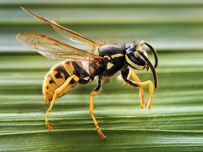 Wasps are up to 30mm long, with two kidney-shaped eyes, two wings folded back along the body and a striking black and yellow pattern.
Wasps are up to 30mm long, with two kidney-shaped eyes, two wings folded back along the body and a striking black and yellow pattern.
A new nest is built annually from a mixture of spit and wood. If you see many wasps coming and going from one hole, crack or opening, it's likely that a nest is present. The nest looks like a grey ball, varying from the size of a golf ball to the size of a car tyre.
There is no reason to kill lone wasps, but they can cause a nuisance if they come into regular contact with people. Wasps feed on fruit and sweet food towards the end of summer.
The sting hurts but is not dangerous, but stings in the throat can lead to the toxin affecting the ability to breathe. In some cases the sting can cause anaphylactic shock; seek medical attention if you suspect someone is going into shock.
What can be done?
In order not to attract wasps into the house:
- keep waste bags and bins away from the house
- seal access points such as vents and cracks around windows and doors
- look for signs of a nest in your loft / attic from time to time over the summer
- don’t kill single wasps – this releases a chemical which attracts other wasps.
It’s not always necessary to destroy a wasps nest; you can leave it alone and it won’t develop into an infestation. Remember that wasps bring benefits by killing other insects in the garden.
A number of treatments are available to get rid of wasps. Before buying insecticides, consider:
- whether you are sure that the flies are wasps
- whether you need special clothing to prevent stinging
- how you will reach the nest
- the effect of infuriating the wasps if the treatment doesn't work.